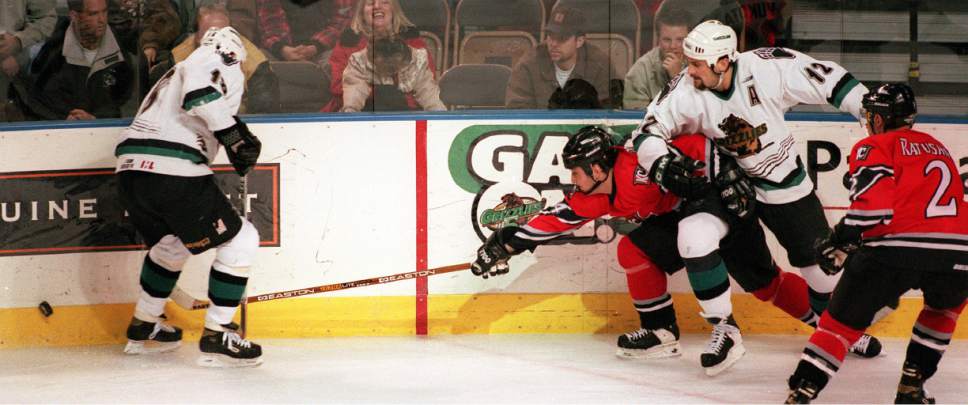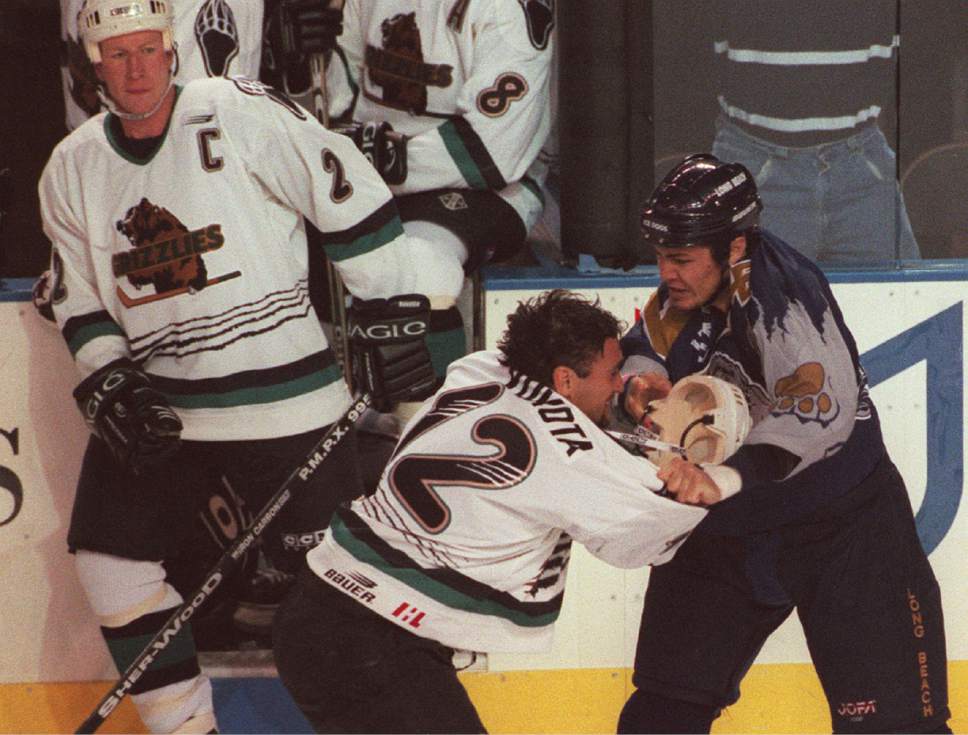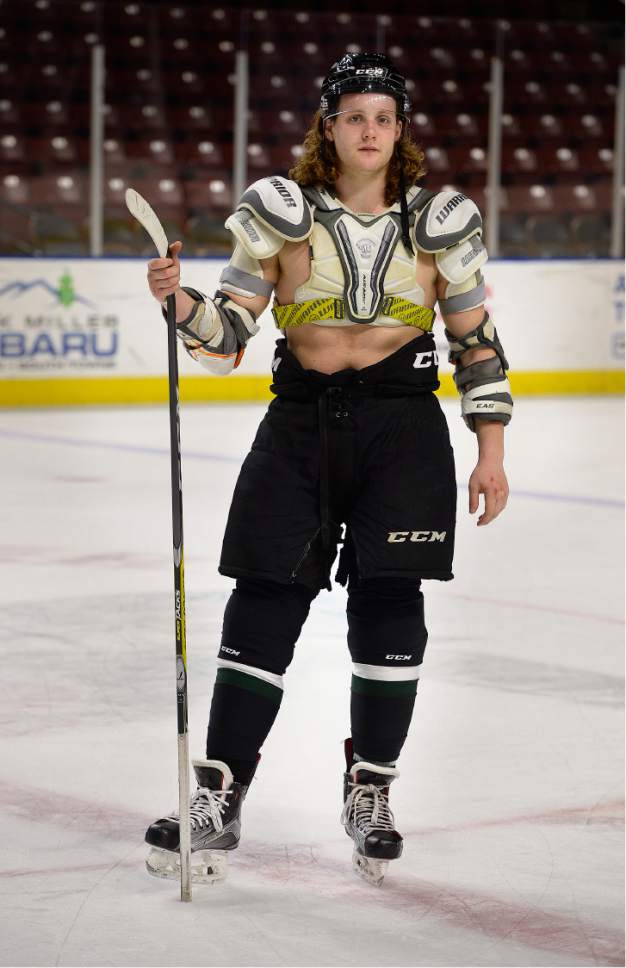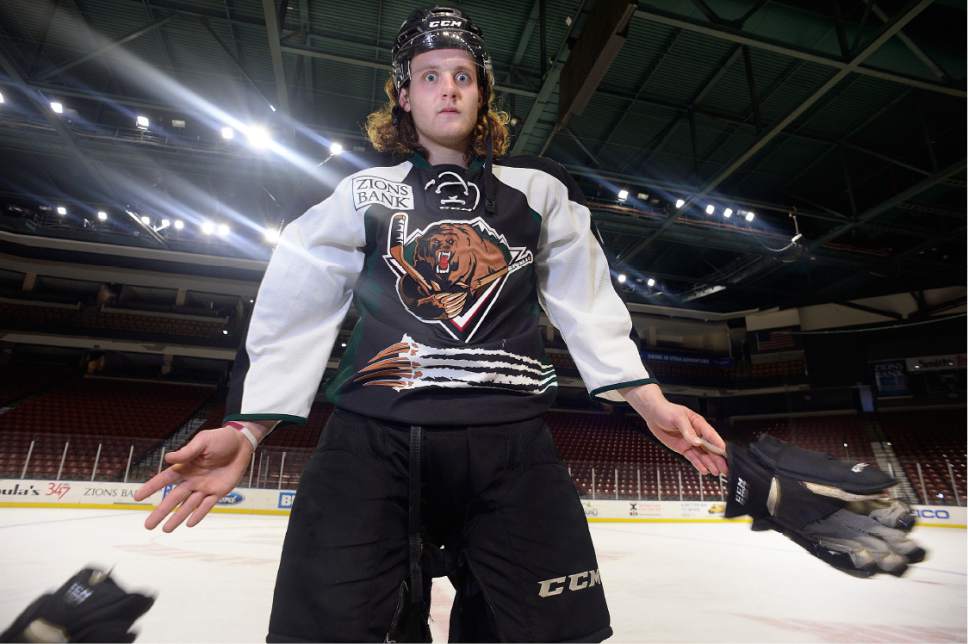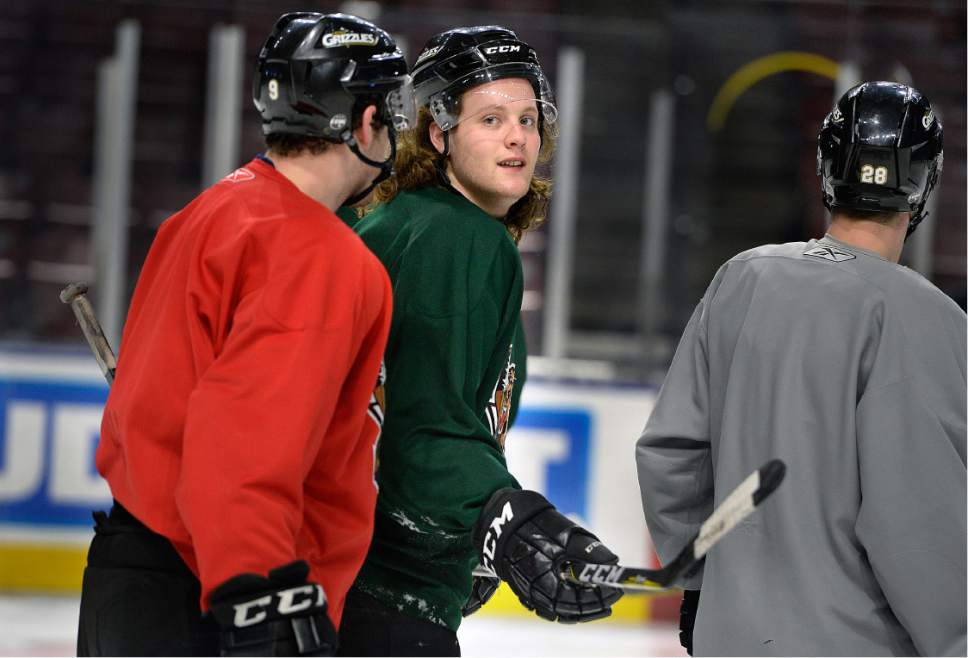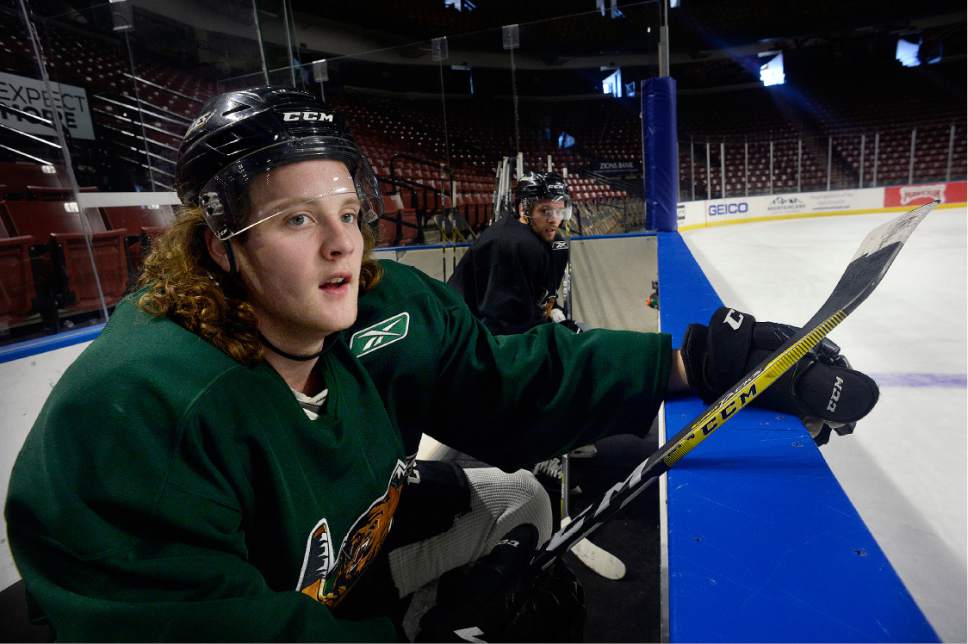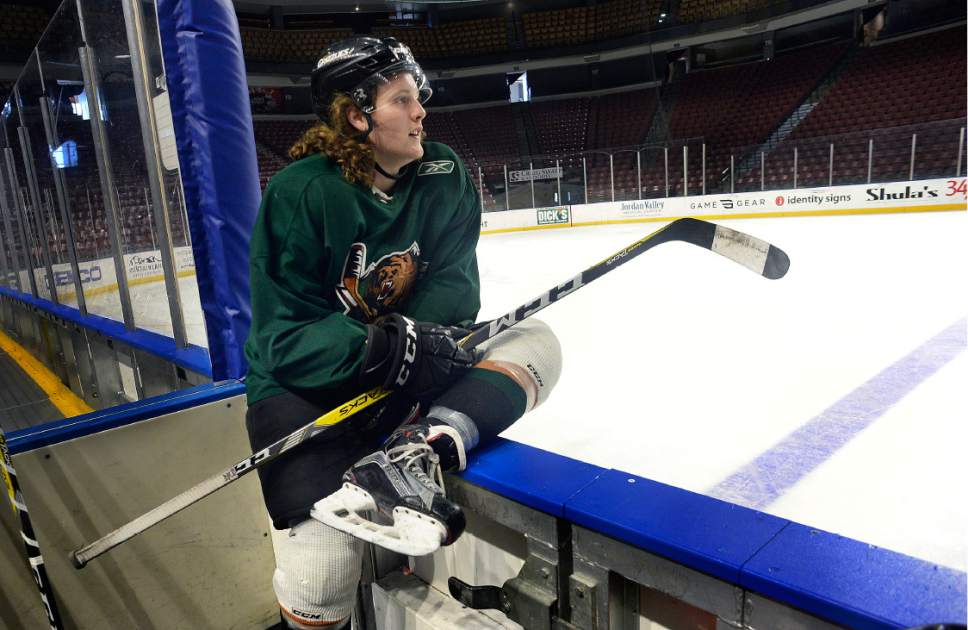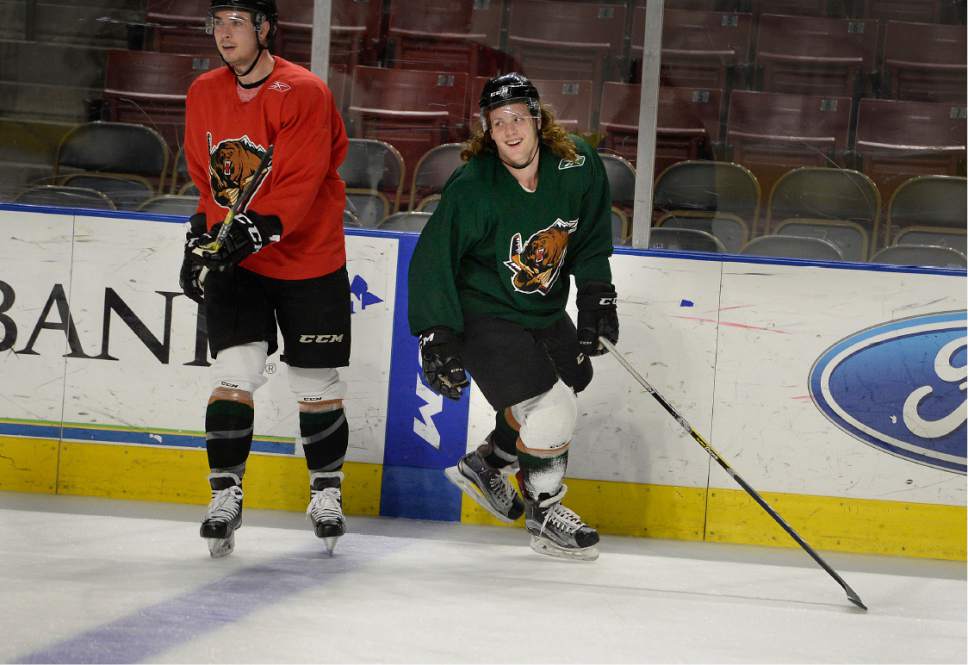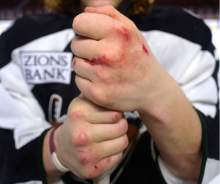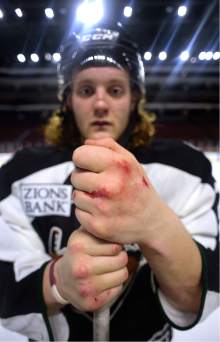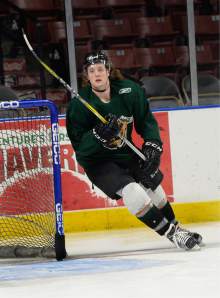This is an archived article that was published on sltrib.com in 2017, and information in the article may be outdated. It is provided only for personal research purposes and may not be reprinted.
Travis Howe still has all his teeth. This is a bit of personal trivia others inquire about all the time and an answer that always surprises them. Some of them have turned gray, passed on as a result of a sudden jab or a surprise lefty haymaker, but they remain in their place. ¶ "I got all my jibs in there," he answers. "A few dead ones, but they're still in there." ¶ How much longer they'll stay there? That's anybody's guess. They've expired, but they're still part of the fight.
As the hulking 6-foot-4, 215-pound Utah Grizzlies forward describes who he is, what he's done and what he's regularly called on to do in professional hockey, the 23-year-old pops his knuckles. He rarely breaks eye contact when explaining what it's like when the gloves drop and the ice dancing from hell begins.
The noise of Howe popping his knuckles accompanies his stories, transporting a listener there. One fist clenched, the other hand left in limbo, waiting to either grab some jersey to start the fight or protect from the first punch.
Howe grew up in Falmouth, Mass., idolizing some of the best brawlers in the NHL. Fighting, he said, is an underestimated part of hockey culture. You learn to take a punch, and you'll survive the game longer. Howe's calling is to provide a scoring option on the Grizzlies' fourth line — or find someone to knock out if the situation calls for it.
"With this role, you almost have to enjoy getting punched in the face, as sick as it sounds," he said. "It's true. I don't mind it at all. I definitely need that one hard shot to wake me up and get me going a bit."
Call him a goon or enforcer or whatever. Howe represents what today is a slowly dying skill in his sport: He's a keeper of the peace, a momentum swinger, a victor. When conflict on the ice escalates to 11, Howe is still one of the guys who answers the bell.
"Guys get knocked out," he said. "S—- happens."
'Sometimes you get pissed off and you fight'
The last time Steve MacIntyre watched three full periods of NHL hockey was the final game of last year's Stanley Cup final. The man known as "Stevie Mac," a 6-5, 250-pound titan, protected teammates when hits got out of hand. He was Howe's hero growing up. He was a hero to plenty of youngsters. Now, he hardly recognizes the sport with so few players like himself on the ice.
"I hate to say it," he said, "but the game I grew up loving is a game I no longer watch because of it."
It still boils MacIntyre's blood to see a player "taking liberties" on the ice and not having to answer for it. Each team deserves to have a player like him to take care of it, says the former Edmonton Oiler, Florida Panther, Pittsburgh Penguin and Utah Grizzly.
The powers-that-be at the NHL have handcuffed guys like MacIntyre, he said, and are weeding out that spot on the roster. According to HockeyFights.com, over 41 percent of NHL games featured a fight during the 2008-09 season; 25 percent of games see two fighters tangle so far in 2016-2017.
The main draws of hockey are the goals, the saves, the hits — and for some, the fights.
MacIntyre's last year of professional hockey was with the Grizzlies. One of the most notorious fighters in hockey history said he'd choose to go to an ECHL game or NAHL game over a prime-time NHL game.
"Those guys were trying to play their guts out to get that next step," he said. "Me, as an old guy, I was just trying to look out for these young little farts."
One of the NHL's all-time tough guys, Mick Vukota, doesn't believe fighting needs to be a spectacle, but it has its place in the game.
"It's not professional wrestling," said the former NHL and Grizzlies enforcer, "but I do believe that the passion of the game should evoke emotion. Sometimes you get pissed off and you fight. The rules allow it."
'This is definitely the only way I know how'
It's not like Howe grew up wanting to be a fighter first and a hockey player second. It's just the way it played out. Howe wanted to make it to the pros, and in trying to get there he figured out quickly that the enforcer role was the one he was best suited to play if he wanted to make a living in the game.
"This is definitely the only way I know how anyway," he said.
Utah coach Tim Branham said if the position of enforcer is dying out, it's because the game has evolved toward a blend of speed and skill; players must be able to do more than just drop the gloves and go for it.
Branham said Howe possesses the ability to read what the game needs at the moment: some sheer hustle to maybe score a goal to pad a Grizzlies' lead or mix in a slobber-knocker against a foe to flip momentum. A good fight can do a lot for a team. When Utah lost enforcer Alex Gallant a year ago, the team's confidence dipped and opponents took more cheap shots.
"If Travis didn't know when to fight, I probably wouldn't have him on the team," Branham said. "If I have to tell him every time, 'Hey, this would be a good time to go fight,' I don't want a guy like that on my team."
He's never had to make that call with Howe.
Grizzlies veteran Evan Stoflet said Howe's presence on the ice eliminates the worry about "riffraff," as he calls it.
"It takes a special mentality to know you're going to go out there every night looking to fight," Stoflet said, "because no matter how good of a fighter you are, you're still going to take some lumps more times than not. You're going up against pretty tough cookies."
'If someone asks you to fight, you don't say no'
Google "Travis Howe" and a series of videos pop up. They're all fights. So many different brawls to choose from. Pick the one from March 28, 2015. You'll come across Howe crouched over, skating at center ice, approaching an opponent he's about to lay into.
He was playing for the Corpus Christi IceRays of the NAHL two years ago. Howe makes first contact. After shuffling his fists, he reaches out with his left hand, grabs hold and with the same hand, connects with five quick jabs before unleashing a big right. Sixteen seconds after Howe finishes his pummeling, he pats his opponent on the back and salutes the jubilant crowd.
Howe's a regular on HockeyFights.com and Dropyourgloves.com. Technique-wise, he said, experience is the best teacher. He'll learn the most about his ability when he loses a fight.
And how does one recover from a licking? No mystery there. Throw some ice on it.
No two fights are the same. Howe said it. MacIntyre agreed. So did Vukota and Stoflet.
"It's not just grabbing a guy and throwing as many punches as you can," Stoflet said. "There's definitely a science to it."
Some fighters grab under the shoulder pads to rid the opponent of his mobility. Others go for the chest and mix in some jabs. Jabs don't hurt, Howe said. They're more of a distraction for what's coming. You get them focused on the left hand making repeated contact to the face, and they forget about the right coming over the top aiming to end it.
It's what precedes a fight — win or lose — that Howe still is trying to perfect. Hockey fights sometimes start out of anger, but not as often as you would think. There have been nights when Howe and another enforcer make eye contact and telepathically say to one another, "Let's go." Wishing one another good luck is a common precursor.
"If someone asks you to fight, you don't say no," Howe said.
However, there are some exceptions — notably when his team is trying to nail down a victory and other guys are trying to stir up things to shift momentum.
And typically, nobody takes the fisticuffs personally. When the fight's been cleared and the adrenaline hasn't allowed them to feel the aching in their fists or the swelling of their lip or eye socket, the two fighters generally have a good laugh about it in the penalty box.
'What was the point of me getting my head busted in?'
Mick Vukota left home at 16. The son of Serbian immigrants growing up in Canada, Vukota came home a bit too tipsy at 3 a.m. and was fired from working with his father, who was a carpenter. The next gig he picked up was as a bouncer. But he didn't learn to fight there. It was protecting his suitcase accordion at a bus stop from unruly neighborhood kids. He fought his way out of it.
Just like on the ice.
"You have a guy on your team that fights the other bully," he said.
Enforcers or a teammate of an enforcer will tell you humility is a required trait. Because you can get knocked silly at any given moment in front of hundreds or thousands or even millions if the game is televised.
You also have to be willing to do anything for your team — on or off the ice. To be the face at a charity event, embrace a sick child at a children's hospital or teach youngsters to fire a puck at a net. Vukota said enforcers can relate to anyone because each night on to the ice, they have to battle a sense of fear.
"The fear of losing," he said.
MacIntyre, a self-described "prairie boy" from Western Canada, recalls the days of farming or framing houses or landscaping to make enough money to get by between his early minor-league years. Away from the arena, Howe recently shifted from landscape work to becoming a sous chef during his offseason. He began working in restaurants back home in Falmouth at 14 and moved behind the line at the age of 16.
Why? McIntyre senses that his job on the ice is being phased out — from the top of the hockey food chain. And he's not happy about it.
"You stuck up for guys, stuck up for teammates and did what you did and now it's like, powers-that-be, wherever they are, saying, 'We're not going to have fighting in the game,'" he said. "What was the point of me getting my head busted in? One minute you say you want it, the next minute you say you don't. Ten out of 10 guys will say would you do it again? Dang right, you'd do it again.
"I went to war for those guys."
'Fighting will be my first-nature'
Standing tall inside the Grizzlies' bench, the sound of popping knuckles continues, this time as Howe points to areas on his massive paws where the toll of landing punches is most apparent. He's had busted bones, dislocated bones, cracked knuckles and his share of torn ligaments in each of his hands. No surgeries have been required, but he has had to play in a cast.
Howe's teeth still being intact might make some laugh, but it's the hands that must be looked after the most. They get the most action. The one time Howe suffered a broken nose didn't come in a round of fisticuffs — it came in youth baseball at 13. He quickly dismisses talk of concussions, saying he's never suffered one in a fight.
Howe not only represents what is likely one of the final generations of tough guys in pro hockey, but what the decline of his type means for the sport's culture. He's had his fair share of guys say "no thanks" to fights, something that Vukota and MacIntyre never could have imagined in their heydays.
"I can probably speak for all of us who do it," Howe said. "I personally hate that you'd go to five straight NHL games and you see maybe one fight. Nothing more bothers me in life. You take away the fighting and guys go around a little bit harder, a little bit cheaper now."
You can't go full goon these days, Howe said. Enforcers who can't even skate backward are extinct. The talent level rises considerably as an enforcer moves up the professional ranks, so Howe is focused on improving with his gloves on. He's required to add to more than a team's penalty minutes if he wants to keep collecting a paycheck.
"I'm definitely working on my game more than anything," he said, "but fighting will be my first nature."
Twitter: @chriskamrani



